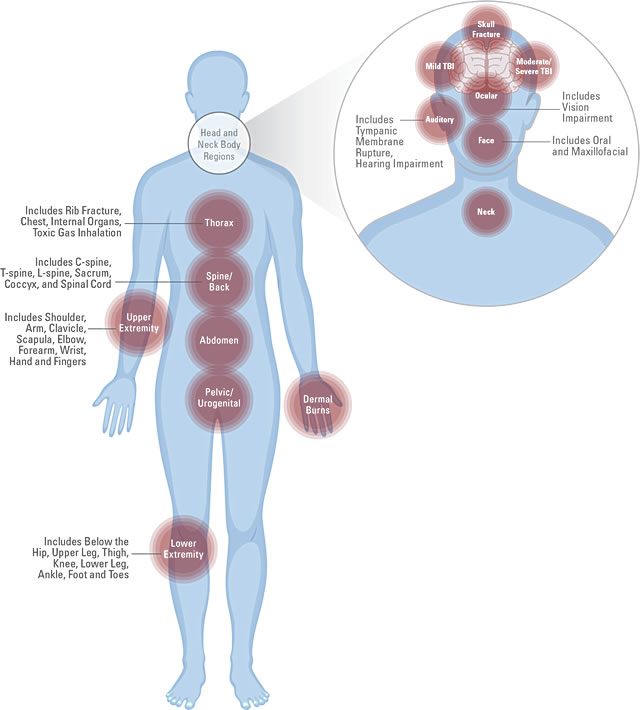After the BIPSR Process was established, the BIRCO sponsored and chaired a series of BIPSR Process Stakeholders Meetings to define the relevant BIPSR Process Blast Injury Types. Through these meetings, Stakeholders classified 14 relevant BIPSR Process Blast Injury Types (see below) on specific body regions. This classification was a shift from an older classification system that referred to individual organs and bones (as described in a 1989 Walter Reed Army Institute of Research [WRAIR] report).
To determine the order that the 14 Blast Injury Types would undergo BIPSR Process review, an objective, Blast Injury Type Prioritization Methodology was developed based on a set of Evaluation Factors (see below). Stakeholders used this methodology to establish the relative priority of the 14 BIPSR Process Blast Injury Types: The Lower Extremity Blast Injury Type would be the first Blast Injury Type to be evaluated by the BIPSR Process, followed by the Spine and Back, and Upper Extremity Blast Injury Types. These BIPSR Process evaluations have concluded, and the BIPSR Process review of the Auditory Blast Injury Type has been initiated and is serving to prove out the iBIPSR Capability.
The BIRCO is currently engaged in a re-prioritization effort for the remaining Blast Injury Types to ensure alignment with the current and future needs of the DoD.
| Evaluation Factors | Description |
|---|---|
| Impact on Operational Readiness | The time for a Service Member to return to duty. |
| Blast Injury Prevalence Rate | The number of cases of a given Blast Injury Type expressed as a percentage of the total number of blast injuries. |
| Treatment Resources | Roles of medical treatment, which are the distribution of medical resources and capabilities to provide Service Member's medical care. |
| Maturity of the Science | Determined by the existence of established standards (e.g., MIL-STD-1474D Noise limits design criteria) or, in the absence of established standards, by the degree to which biomedically-valid injury mechanisms have been published in the peer-reviewed scientific literature, or by the development and application of assessment methodologies based on the established injury mechanisms to assess injury risks. |
| Rehabilitation Resources | Resources required to support a Service Member's rehabilitation beyond immediate treatment resources and may include therapy, pharmaceuticals, or devices needed to reset for quality of life. |
| Disability Percentage | Designated percentage assigned to an injury type when calculating disability benefits. |
The BIRCO continues to implement the BIPSR Process with support from the MITRE Corporation. In FY23, the BIPSR Process Evaluation for the Auditory Blast Injury Type was completed, and a recommended Standard has emerged with some notable areas of need for developing future knowledge.
To date, six Blast Injury Types have been completed or initiated. The remaining eight Blast Injury Types will be evaluated in the rank order determined by the re-prioritization effort. Please contact the BIRCO for more information, to get involved, or to obtain copies of reports on completed Blast Injury Types.

Click image for downloadable PDF of blast injury graphic (213 KB)
Lower Extremity
The Lower Extremity Blast Injury Type has completed its BIPSR Process evaluation; findings and recommendations are being shared with the DoD S&T community.
Spine and Back
The Spine and Back Blast Injury Type has completed its BIPSR Process evaluation; findings and recommendations are being shared with the DoD S&T community.
Upper Extremity
The Upper Extremity Blast Injury Type has completed its BIPSR Process evaluation; findings and recommendations are being finalized.
Auditory
The BIPSR Process for the Auditory Blast Injury Type has been initiated. In collaboration with the MITRE team, the BIRCO is proving out the iBIPSR capability,
using the Auditory Blast Injury Type as exemplar.
Dermal Burns
The Dermal Burns Blast Injury Type will be calling for Stakeholder participation soon. If this is an area of expertise and interest to your organization,
please contact the BIRCO for more information on how you can support our Service Members through participating in the BIPSR Process.
Your 15 minute session will timeout in approximately 10 minutes.
If you're in the middle of entering information, please close this warning and save your progress (if possible) or finish up your task.
If your session fully times out, you will lose any un-saved work.
Your current Blast Injury Research Program session has expired.
Your next click will take you away from the private area, and you will lose any work you have in-progress.
Please enter your email address, and try again.